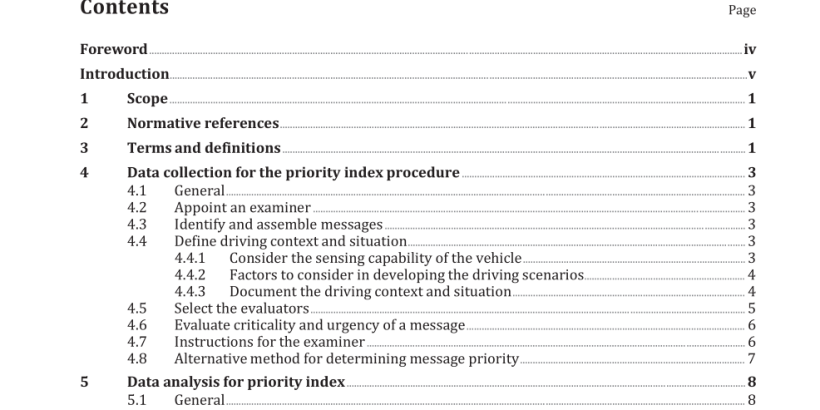ISO/TS 16951:2021 pdf download – Road vehicles — Ergonomic aspects of transport information and control systems (TICS) — Procedures for determining priority of on-board messages presented to drivers.
4 Data collection for the priority index procedure 4.1 General This clause presents the steps for collecting the data used to calculate a priority index for each message. See the example outputs given in Annex E and Annex H . 4.2 Appoint an examiner The priority index procedure requires an examiner to coordinate the data preparation, analysis, and reporting. The role of the examiner is detailed in 4.7. The examiner shall be familiar with the prioritization process, knowledgeable on message management, and have automotive experience. If the examiner has similar qualifications to that of the evaluators, the examiner may participate as both an examiner and evaluator. 4.3 Identify and assemble messages It is necessary for the examiner to identify in advance messages that are to be presented to drivers. The messages represent the aggregate output given by the TICS and non-TICS connected to a message management system. The examiner shall collect these messages and prepare them for presentation to the evaluators.
4.4 Define driving context and situation For each message, the examiner shall define, or assist in defining, a driving context and situation in terms of the road environment and the traffic condition in which the message is likely to be presented. The contextual and situational factors should be defined at the moment when the message is presented because the priority (assignment of criticality and urgency ratings) depends heavily on the driving context. Particular attention should be given to the presentation of messages in potentially hazardous situations. All hazardous situations should be considered, except for highly unlikely possibilities. Based on these situations the examiner may define one or more (normally not more than four) scenarios for a particular message. The same message in two different scenarios shall be regarded as two different information items to be evaluated. This is because messages may occur in several different driving contexts, and each context could yield a different message priority. For example, the priority given to a message pertaining to a system malfunction will be different depending on whether the driver is starting the car or is relying on the system whilst driving. If only one scenario is used for a given message, that scenario should represent a reasonable “worst- case ” situation. At minimum, a TICS or non-TICS expert and the examiner should agree on the worst- case driving scenario. A traffic safety expert may also be consulted.
4.4.2.1 Trip context The trip context is a factor that considers the aim of the trip (e.g. commuting, leisure), the timing or position along the route (e.g. relative position between start and destination), and the preparatory distance to the next manœuvre. EXAMPLE “Close (e.g. 20 m) to turn (or merge)”. 4.4.2.2 Road environment The road environment is a static factor related to road structure that affects driving. Considerations shall include the road type (e.g. highway, urban road, country road), the speed limit, the number of lanes, and the road width. Consideration shall also be given to the effect on driving of the surrounding environment, including weather conditions and time of day (e.g. morning, daytime, night-time, raining). 4.4.2.3 Traffic situation The traffic situation is a dynamically changing factor related to traffic or obstacles on the road that affect driving. Considerations here include the relationship to other vehicles, such as headway distance and speed difference to the lead vehicle. EXAMPLE 1 EXAMPLE 2 EXAMPLE 3 Headway distance. Lateral vehicle exists. Speed difference to the lead vehicle. 4.4.2.4 Vehicle condition This factor originates from the vehicle itself and derives from the relationship between the vehicle and the road. Vehicle condition can be separated into “vehicle type ” and “vehicle state”. EXAMPLE 1 Vehicle type: “passenger vehicle ”, “heavy vehicle ”. EXAMPLE 2 Vehicle state: “driving speed ”, “driving in left [right] lane ”, “negotiating curve [intersection] ”, position of the vehicle within a lane.
